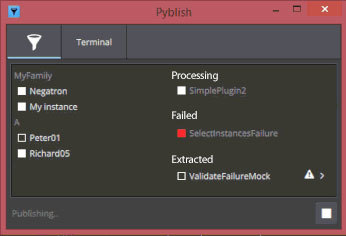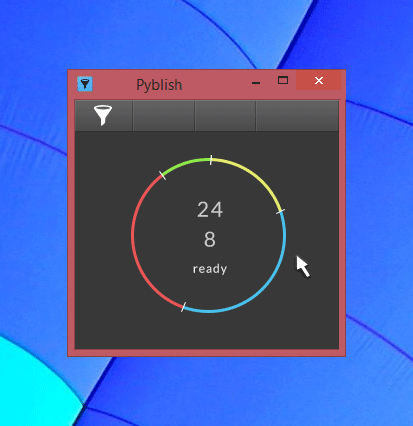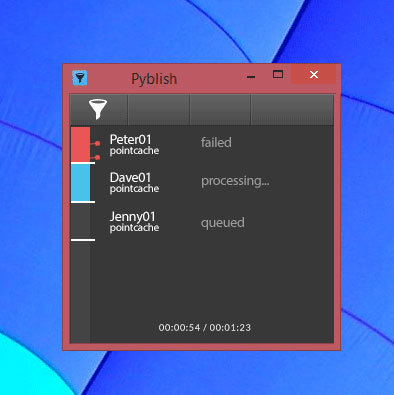Great suggestions everyone. About this last one, I like the minimalism of it, but don’t you think it can get a little bit confusing, or even frustrating seeing things pop up you didn’t know were there?
I don’t think the artist care about that. It is certainly annoying for developers, but developers would know to look in the overview.
I agree with @tokejepsen here. Artist really don’t need to know what is being validated, unless it fails. Best case scenario, where artist had a a very clean scene, it gets published without bothering him at all. Worst case, he gets a list of things he needs to deal with.
Maybe I’d add a little status bar on the bottom, which would just print what is being done currently so he get’s progress of publish in some way. You can seen what is being processed now by it being highlighted in the UI, so equivalent of that. Just so it doesn’t look frozen if everything goes well and it takes a while.
Thats a good point. +1 for progress bar or similar.
I’ll plus 1 this too, having recently had some experience with this from an artist’s perspective, I can see how most things in that list are a nuisance unless they need my attention.
As a hint, I think implementing this should be very simple; the mechanics of hiding and showing items dynamically based on their data within the model is already there (it’s what happens when there are no supported families, for example), and the data already being updated.
It’s done through a “proxy” that either includes or excludes items based on their data, so you could simply add another filter to it to only include items with it’s data hasError set to true.
Either way is good. I think right now, the Overview is sort of a mix between two ideals; one where we see everything, and one where we only see what is relevant at the time.
If we go the route of slimming down the overview to only showing relevant things, and making a new view for the more “expanded view”, or if we go the other way around, making a new view for relevant things, I think both are good paths to take. Whichever is simpler to implement might make sense to implement first.
I posted this elsewhere but should reference it here as well: Simpler GUI mockup
A simpler overview for the artists:

The overall idea is:
- Remove the notion of the “Context” in that view.
- Show only the currently running plug-in instead of the complete list
- This would show on the right side under a header like
Processing...or even related to the plug-in type that’s being run, likeCollecting...,Validating...,Extracting...
- This would show on the right side under a header like
- Show only the failed plug-ins (or those that require attention of the artist in any other way)
- Similarly whatever got extracted might be of use to the artist, so the “Extracted” content could be shown.
- The overall “feel” is very similar to the current more verbose overview to hopefully allow transfer most of the features implemented. Like actions and alike.
- Still allow artists to enable/disable an instance. (Again in a similar “view” as it is currently so the “toggle all” functionality could likely transfer here too)
I think it’s important to:
- Reduce the overall size/complexity of the UI required to show the information the artists need. (So less clutter, unnecessary information or too technical verbosity)
- Less is more.
This would be an additional tab that runs as the default one.
As such more in-depth debugging could still be done.
Here’s one from me.

Like @BigRoy suggested, the tabs would provide access to the current overview and this could serve as a landing page.
Some of the things happening in the gif.
- It starts by showing you how many plug-ins, and many instances. 24 and 8 respectively. A tooltip could potentially display that that’s what the number represents, and isn’t something I think needs to be permanently stated as a label or such to the numbers.
- Inside the circle is the info and interactive area, it shows briefly what it is doing or what will happen if you click it.
- The colors around the circle illustrates the division of Collectors, Validator, Extractors and Integrators respectively; the Yellow section filling up during reset.
- The timer at the bottom shows time passed and expected time to finish. It’ll have to do this based on averaging prior publishes, something we can have a look at now, since @tokejepsen implemented callbacks and we can now start storing things in the host.
- On failures, red flags appear
- Each flag illustrating a plug-in that fails
- Each flag when hovered displays a message in the inner circle
- Right-clicking a flag brings up the actions for that plug-in.
- Hovering a colored section tells you how many plug-ins are in that particular segment.
Thoughts
As I was making this, it occurred to me that a straight-line version might be an interesting alternative. It would feature the exact same thing, but either be a horizontal or vertical line, where the rest of the GUI would be populated with the status messages, and probably do a better job at it too.
Here’s one from me.
Wow, alternative! 
What about optional plugins?
If we are to have some plugin/context input from the user at some point. The user would need to select a plugin.
Maybe they could each have a little white checkable flag? Filled versus hollow for checked status.
Or maybe, when you hover that portion of the circle, checkboxes could appear where there are optional plug-ins?
Very interesting.
Somehow I’m completely missing what the artist would still want to manage/see easily, like the toggling of instances so they know there work is “processed” like they think it is. (For example seeing rig / Peter01). Just some basic reassurance of what will be processed before clicking “Play”.
I’m also thinking the Artist cares less about the amount of Plug-ins that will be run, but more about what Instances are processed for what “family” (and for them they are not interested in “family” since they won’t know what it means without some Pyblish background). They would be interested in what’s processed and does it process and produce the output I’m expected to create from my work file.
Even though I love the look of this I’m imagining this particular one to be a “sidebar” kind of thing or one that would be nice for something that processes in the background: Just a “ok it’s processing” feeling than something you would open up to investigate for seeing the information. Does that make sens?

Here’s another minimal mockup based on your circular one. This kind of provides the information that I’m assuming the artist is looking for.
Still I’m thinking that the features like “toggle all” for a specific family was added based on Artist’s requests. So even in the minimal form I’d opt for a structure (or layout) that would allow you to see them “grouped” by family where you’d be able to click the family and toggle all…
What I think is the minimum that needs to be in the ‘artist’ view. When it opens up
- List of instances and ability to toggle them on and off. (practically the same as instances now, but maybe nicer design.)
- Any optional extractors
When it runs
- progress bar, ideally stating what it’s just doing
After it finishes
- Any failed plugins so we can run actions on them, look at the problems and deal with them.
Actually concerning the plugins that show up in the ‘artist’ view. A simple flag in the plugin stating if it should show might be ideal. artist_view = True just like we use order, optional etc. That way developer could control what the artist will see. I might want to show them for example extractors that get the main data out as .abc, .obj. .ma, where some of those might be optional but not necessarily.
That’s a great idea.
Sounds like a good idea. Was reading yours, and thinking that I wouldn’t have extractor showing:) All studio related taste.
Hence the artist_view flag.
When we transfer assets between softwares artists like to choose what they are exporting. Also I’d like them to know what is their output, so it’s not fully magical in the BG 
Was thinking along those lines as well, so +1.
I imagined it specifically useful for the Extractors (or even Integrators) if the Integrator has some Action to explore the integrated content on disk. So they might right-click the final output and “browse that location”. Where of course browsing that location could be “showing it” through a proprietary asset management system when required, as usual Actions can be anything really. Just keeping in mind that some functionality from the “overview” would transfer to the “artist view”.
Apologies that I’ve only skimmed this thread. With regards to plugin clutter, I feel like this could be solved just by grouping the plugins by collectors, validators, extractors and integrators. So by default an artist only sees 4 tasks in the list, and if one of them fails, the group could be automatically expanded to show the details of which plugins failed and why. I think this has the added benefit of drawing attention to the CVEI paradigm, since it’s core to the pyblish workflow. Already I’ve starting prefixing plugins with "Collect: " etc. so that it’s clear where the splits are between phases of the publish. I’d prefer that to an artist view, since in this case you’d be organizing information and keeping it accessible rather than hiding it.
Sorry just now saw this: https://github.com/pyblish/pyblish-qml/issues/189 which seems in-line with what I was thinking.